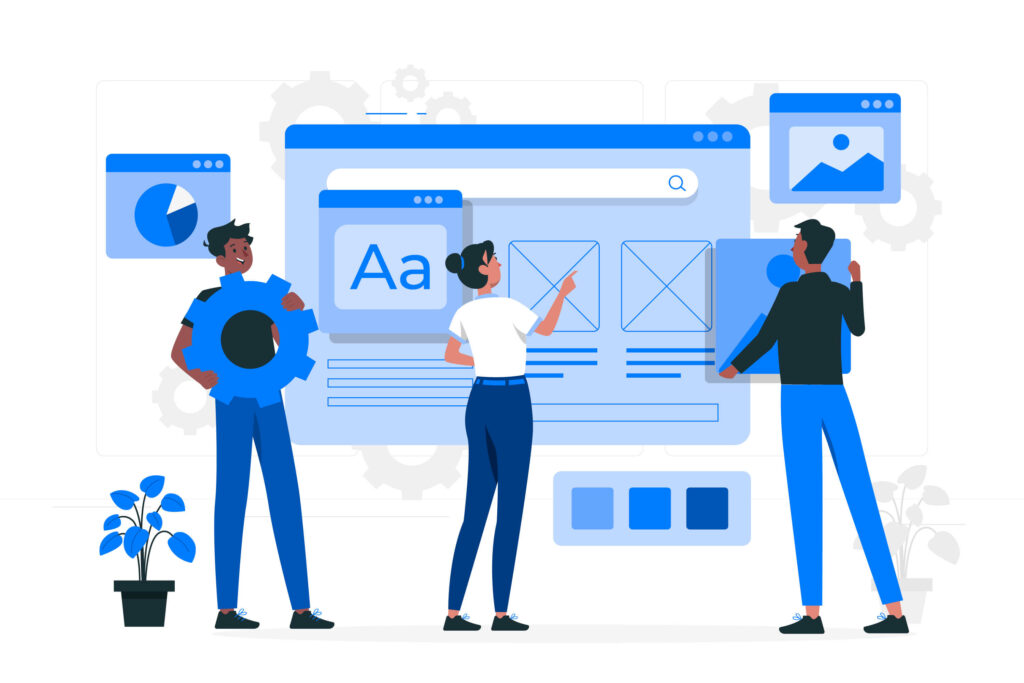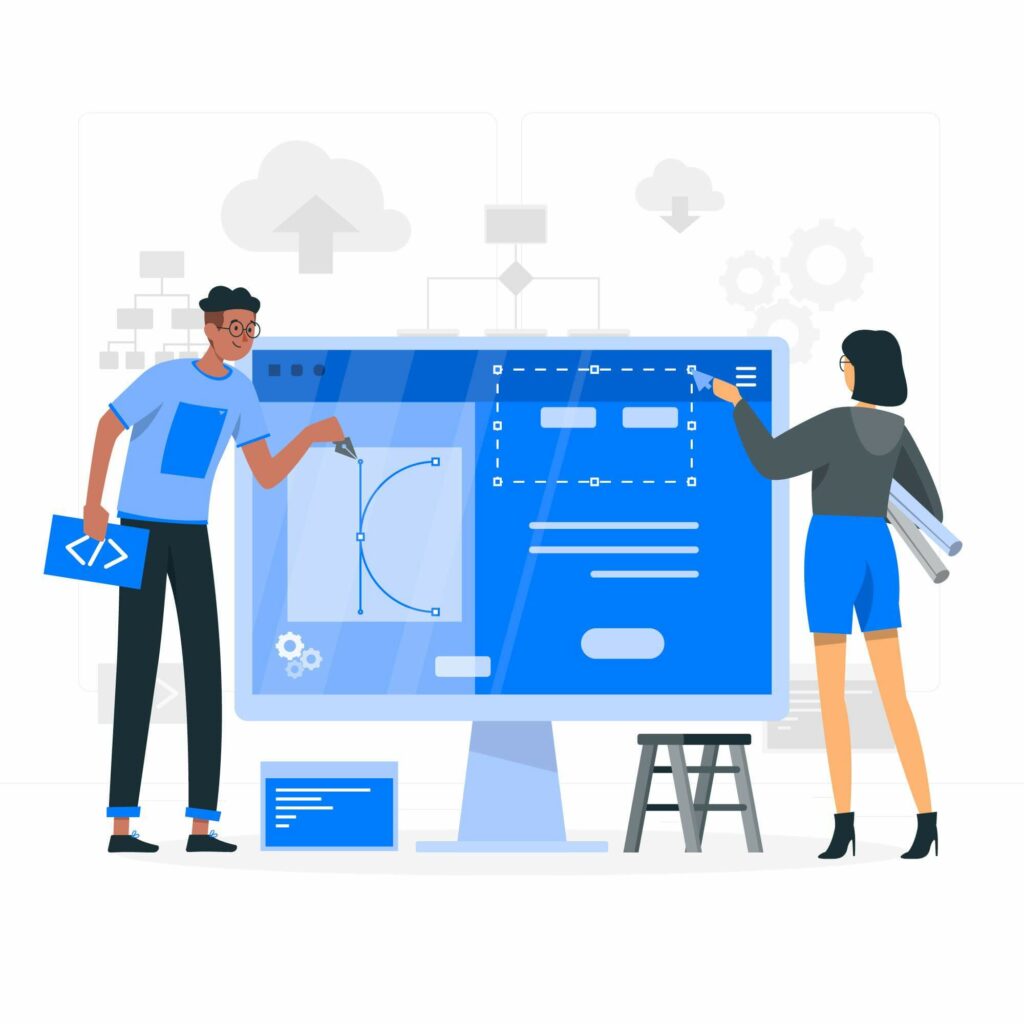What is Website Designing?
Website designing is the art of creating attractive and user-friendly websites. It involves choosing colors, fonts, images, and layout to create a captivating user experience. The goal is to make the website both visually appealing and easy to navigate, ensuring a seamless user journey and effective brand communication.

Web design vs Website development
When discussing websites, two terms often come up: web design and website development. While they may sound similar, they refer to different aspects of the website creation process.
Web design focuses on the aesthetics and visual aspects of the website. It involves creating a visually appealing layout, selecting color schemes, choosing typography, and incorporating images and other visual elements. The goal of web design is to create a beautiful and engaging user interface that enhances the overall user experience.
On the other hand, website development deals with the technical aspects of building a functional website. It involves coding and programming to bring the design to life and make the website fully operational. Website developers use various programming languages like HTML, CSS, JavaScript, and more to create interactive and responsive web pages.
casino online sanremo Sanremo Casino Online provides secure deposits and quick withdrawals
Primary Benefits of a Good Web Design
Having a good web design is crucial for your online success. It not only creates a positive first impression but also improves user experience, increases trust, and boosts your search engine rankings. With a well-designed website, you can effectively convey your brand message, engage visitors, and ultimately drive more conversions and business growth.

What Do Web Designers Do?
Web designers play a significant role in designing visually attractive and effective websites. They combine creativity with technical skills to design layouts, choose colors, and select fonts that resonate with your brand. Additionally, web designers ensure that your website is user-friendly, responsive, and accessible across various devices. They collaborate with developers and content creators to bring your vision to life, resulting in a seamless online experience for your audience.
What are web design techniques?
Web design techniques refer to the various methods and approaches used by designers to create effective and engaging websites. These techniques include:
- Responsive Design: Ensuring that the website adapts and looks great on different devices and screen sizes.
- User-Centric Design: Focusing on the needs and preferences of the users to provide an intuitive and enjoyable experience.
- Visual Hierarchy: Organizing content in a way that guides users’ attention and emphasizes important elements.
- Color Psychology: Using colors strategically to evoke emotions and convey the brand’s personality.
- White Space: Employing empty spaces to improve readability and give a clean and organized appearance.
- Typography: Selecting fonts that are clear to read and fit the design as a whole.
- Call-to-Action Placement: Placing buttons and links strategically to encourage user interaction.
- Image Optimization: Compressing images to enhance loading speed without compromising quality.

By employing these techniques, web designers create websites that not only look visually appealing but also deliver a seamless and user-friendly experience.
What are the types of web design?
Certainly! Web design can be categorized into various types, each with its unique characteristics and purposes. Some common types of web design include:
- Static Web Design: In this type, web pages remain fixed and do not change unless manually updated. It is suitable for simple websites with infrequent content updates.
- Dynamic Web Design: Websites with dynamic design feature content that is updated in real-time. This type is ideal for sites that require frequent updates or user-generated content.
- Responsive Web Design: A responsive design ensures that the website adapts and looks great on different devices and screen sizes, providing an optimal user experience.
- E-Commerce Web Design: Specifically tailored for online stores, e-commerce design focuses on showcasing products, facilitating secure transactions, and providing a smooth shopping experience.
- Single-Page Web Design: Single-page websites have all their content on a single page, making navigation simple and straightforward.
- Parallax Web Design: Parallax design creates a 3D effect by moving background images at different speeds while scrolling, adding depth and interactivity.
- Minimalist Web Design: This type uses clean and simple layouts, limited color palettes, and concise content to emphasize key messages and improve user focus.
- Illustrative Web Design: Incorporating hand-drawn or illustrated elements, this style adds a playful and artistic touch to the website.
Each type of web design has its strengths and can be chosen based on the specific needs and goals of the website and its audience.
Principles of design applied to websites
To create a visually appealing and effective website, web designers apply various design principles. These principles help maintain balance, contrast, emphasis, movement, rhythm, hierarchy, white space, and unity on the website. Each element plays a crucial role in directing users’ attention and creating a harmonious user experience. To create visually appealing and user-friendly websites, designers apply fundamental principles of design, such as:
- Balance: Ensuring elements are distributed harmoniously across the page.
- Contrast: Creating visual interest through differences in color, size, or shape.
- Emphasis: Drawing attention to specific elements to guide the user’s focus.
- Movement: Using visuals to create a sense of direction and flow.
- Rhythm: Establishing visual patterns that create a sense of unity.
- Hierarchy: Organizing elements to show their relative importance.
- White Space: Utilizing blank areas to enhance readability and reduce clutter.
- Unity: Coordinating design elements to create a cohesive look and feel.
Website layouts
Website layouts are the arrangement of different elements on a web page. A well-thought-out layout ensures that the content is presented in an organized and user-friendly manner. Common website layouts include single column, multi-column, grid-based, and full-screen layouts.Website layouts determine how information is presented to users. Common layouts include:
- One-Page Layout: All content is on a single page, offering a seamless scrolling experience.
- Grid Layout: Organizing content in a grid pattern for a structured appearance.
- Magazine Layout: Mimicking the style of a magazine with multiple sections and visual appeal.
Functional components of web design
A well-designed website should prioritize the following functional components:
- Navigation: Intuitive menus and navigation structures for easy browsing.
- Speed: Fast-loading pages to reduce bounce rates and enhance user experience.
- SEO: Incorporating search engine optimization techniques to improve visibility in search results.
- UX: Ensuring a user-friendly experience with clear call-to-actions and intuitive interfaces.Adaptive Design vs. Responsive Design: Choosing between adaptive and responsive design approaches to optimize site display across various devices.
UX (User Experience) Elements:
User experience is crucial to keep visitors engaged. Key UX elements include a website that is:
- Useful: Providing valuable information and resources to users.
- Usable: Offering easy navigation and intuitive interfaces.
- Findable: Ensuring content is easy to locate through proper organization and search functionality.
- Credible: Establishing trustworthiness through well-presented content and secure transactions.
- Desirable: Creating a positive emotional response and attractive design.
- Desirable: Creating a positive emotional response and attractive design.
- Accessible: Ensuring the site is inclusive and can be accessed by all users.
- Valuable: Delivering meaningful and relevant content that addresses users’ needs.
Visual elements of web design
To capture users’ attention, visual elements play a vital role:
- Website header: The header is the top section of a web page that typically contains the site’s logo, navigation menu, and contact information.
- Website footer: The footer is the bottom section of a web page that often includes copyright information, links to important pages, and contact details.
- Color scheme: The color scheme sets the overall tone and mood of the website and helps establish brand identity.
- Typography: The website’s readability and design are impacted by the font and typeface choices.
- Website background: The background contributes to the overall look and feel of the website and may be solid, textured, or contain patterns.
- Imagery: High-quality images and graphics enhance the visual appeal of the website and convey messages effectively.
- Animation: Carefully used animations can add interactivity and engage users, enhancing the overall user experience.
Website maintenance
Even after launching a website, the work is not over. Website maintenance is essential to ensure that the site continues to perform optimally. Regular updates, bug fixes, security checks, and content revisions are all part of website maintenance. By keeping the website up-to-date and well-maintained, businesses can provide users with a seamless experience and stay ahead of the competition.
Conclusion
In conclusion, effective web design is a delicate balance between aesthetics and functionality. By implementing the principles of design, considering UX, and incorporating visual elements thoughtfully, businesses can create stunning and engaging websites that leave a lasting impression on their visitors. Additionally, investing in website maintenance ensures that the site remains in top-notch condition, delivering a positive user experience in the long run.

